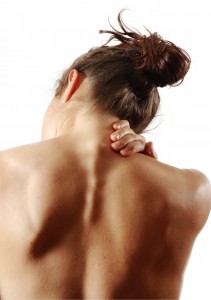“Yeeoohhh!” Were you exerting yourself, tensing muscles beyond measure and then felt something tear, rip or pull? Was it followed by terrible pain, severe spasm in the muscle affected and a need to stop all activity immediately? You’ve likely strained muscle, and it’s going to take some time to heal. Muscles and joints handle tremendous loads. Everything from shoveling snow, lifting heavy boxes and carrying groceries. They endure prolonged postural loads when sitting at the computer desk, and if the body is overwhelmed with excessive or prolonged load, muscles and connective tissues may strain, causing inflammation, guarded movement and pain.
 In addition to redness, swelling, immobility, pain, and heat over the area, you will notice muscle spasm – it’s the muscle’s way of shutting down movement and splinting the injured area. If you notice excessive bruising and/or swelling, heard a “pop” sound or cannot use the limb or bear weight in your spine at all – seek immediate medical attention. The physician or nurse practitioner may suggest a supportive bandage or splint, crutches or other assistive device, offer a prescription for non-steriodal anti-inflammatory drugs (NSAIDs) and in severe cases (for a mostly or fully ruptured muscle) surgery may be required.
In addition to redness, swelling, immobility, pain, and heat over the area, you will notice muscle spasm – it’s the muscle’s way of shutting down movement and splinting the injured area. If you notice excessive bruising and/or swelling, heard a “pop” sound or cannot use the limb or bear weight in your spine at all – seek immediate medical attention. The physician or nurse practitioner may suggest a supportive bandage or splint, crutches or other assistive device, offer a prescription for non-steriodal anti-inflammatory drugs (NSAIDs) and in severe cases (for a mostly or fully ruptured muscle) surgery may be required.
If the strain is less severe, apply PRICE – protection, rest, ice, compression and elevation – immediately and frequently (every hour for 20 minutes duration) over the next 24-72 hours. This will help diminish the symptoms. When symptoms abate, move the joints on either side of the strain within pain-free range while gently, gently tensing and relaxing the affected muscle (isometric contraction) for a count of 5 followed by 3 seconds relaxation, for 3 – 5 repetitions twice/day.
Eventually work up to weight-bearing and non-straining activities (example: a short walk, gentle stretching regimen) and eventually increase activity back to normal levels. It’s very important to modify activity and increase gradually…injuring a muscle already strained will dramatically impact your recovery and the prognosis for a full recovery.
You can lessen your chances of strain through regular physical conditioning and a daily stretching regimen. When exercising, stretch gently before exercise and a bit more vigorously after (when the muscles are warm and responsive). Maintain sufficient rest and nutrition, and be careful when bending or twisting while handling heavy objects.
Massage Therapy for Strain
Massage therapy is indicated after 24- 72 hours of PRICE. Your practitioner can relieve some of the painful spasm, reduce excessive swelling and treat compromised and compensating body regions directly or indirectly affected by the injury. Don’t worry…your practitioner will not provide deep tissue penetration into the injured muscle while acute! Over time, your practitioner will help mold and make pliable the scar tissue your body produces to repair the injury, eventually restoring it to maximum efficiency.
A recent research study provides some insight why massage is helpful in the treatment of strain and inflammation.
Mark Tarnopolsky, MD, PhD, and colleagues from the Department of Pediatrics and Medicine at McMaster University in Hamilton, Ontario, Canada reported the results of their research in the February 1 issue of Science Translational Medicine.
“Ten minutes of massage therapy can help repair exercise-induced muscle damage by subduing inflammation and renewing mitochondria (the cell’s “power plant”). This mechanism is similar to the way non-steroidal anti-inflammatory drugs (NSAIDs) work.”
“In summary, our findings suggest that the perceived positive effects of massage are a result of an attenuated production of inflammatory cytokines (signalling molecules in intercellular communication), which may reduce pain by the same mechanism as conventional anti-inflammatory drugs such as NSAIDs. The results elucidate the biological effects of massage in skeletal muscle and provide evidence that manipulative therapies may be justifiable in medical practice,” the researchers conclude. [i]
“There is general agreement that massage feels good, now we have a scientific basis for the experience,” said coauthor Simon Melov, PhD, from the Buck Institute for Research on Aging, Novato, California, in a press statement.[ii]
[i] Study Shows Why Massage Aids Exercise Recovery http://www.medscape.com/viewarticle/757978
[ii] ibid
 Follow
Follow